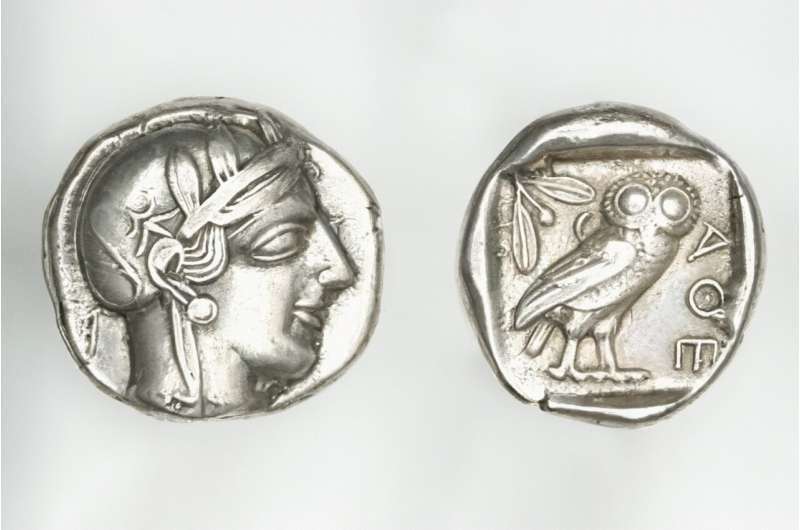This article has been reviewed according to Science X's editorial process and policies. Editors have highlighted the following attributes while ensuring the content's credibility:
fact-checked
trusted source
proofread
Researchers help study and catalog museum's ancient Greek coins

Did you know the change rattling in your pocket is similar to coins used in ancient Greece?
In fact, the current design of our quarters, loonies and toonies is almost identical to those used more than 2,000 years ago—an insight the University of Toronto's Ben Akrigg is keen to share with a wider audience.
An associate professor in the department of classics in the Faculty of Arts & Science, Akrigg is working with a team of scholars and the Royal Ontario Museum (ROM) to study, catalogue and publish information on more than 2,000 ancient Greek coins through the ROMkomma project.
"Greek coinage is so interesting because it's almost the earliest coinage—at least in the Western tradition of coinage," Akrigg says. "The idea is to make sure that our high-resolution photographs and up-to-date identification, dating and commentary are available on the museum's website for anyone who wants to look at them."
The ROMkomma project—komma means "impression of a coin" in ancient Greek—launched last year. Akrigg works alongside Boris Chrubasik, an associate professor and chair of the department of historical studies at U of T Mississauga; Kate Cooper, an assistant professor, teaching stream, in the department of historical and cultural studies at U of T Scarborough; as well as a team of graduate students.
The first phase of the project, which wraps up in 2024, focuses on about 250 coins from two regions of ancient Greece: the city of Athens (sixth to first centuries BCE) and the cities of the Hellenistic empire of the Seleukid rulers (fourth to first centuries BCE).
Akrigg and his team are providing information such as the weight, size and dimensions of each coin, an approximate date it was minted, what the markings mean and other relevant information about its use and significance in ancient Greek history.
While the bulk of the updated information is housed in a database for ROM internal use only, there is a small database available to general public.
"To some extent, we can trace changes in the economies and the day-to-day lives and day-to-day uses of money in Greek cities by seeing what kinds of coins they're minting," Akrigg says.
To update the database, the team had to first refer to the original files from the ROM—some of which were decades old—and put their research talents to good use.
"My favorite part was looking for 'mystery coins,'" says Anastasia Zabalueva, a Ph.D. student in the department of classics.
"Some old printed pictures of coins had incorrect inventory numbers or did not have a number at all—so we had to identify the right number so that we could match the picture and the page of coin in the database."
Zabalueva and her colleagues also searched filing cabinets and other source materials to ensure the descriptions were accurate, sometimes comparing and matching descriptions with those from other international ancient coin collections.
"We felt like detectives solving a mystery," she says.
Most of the coins are made from silver and all were made by hand. First, a blank coin was heated to become softer and placed on a die containing the design on the one side—the obverse or "heads" side. Then another die containing the design of the other side—the reverse or "tails" side—was placed on top and was struck by a hammer, creating a two-sided coin in a single blow.
One group of coins the team is studying is from ancient Athens, one of the earliest Greek cities to create its own coinage in the middle of the sixth century BCE.
"If you look at the Athenian coins, what's striking is that they're instantly recognizable as coins, monetary instruments like ours—and partly because, in many ways, they resemble the coins we have in our pocket," Akrigg says.
On the "heads" side, many of these coins have a profile image of Athena—the goddess of wisdom and war, and the city's protector. The other side of the coins display symbols associated with Athena such as an owl or an olive branch.
"The owl is a symbol of wisdom associated with the goddess, though owls have other meanings as well," says Akrigg.
Later coins from the Seleukid Empire often placed rulers on the face of the coin—especially Alexander the Great, with the image of a god such as Zeus or Apollo on the reverse, as well as a variety of creatures such as turtles, lions, elephants.
"At the end of the fourth century BCE, some of Alexander's successor kings put Alexander's portrait on their coins, but then after a while, the kings thought, 'Hang on, why don't we just put ourselves on?'" says Akrigg. "And so coins became a way to assert their own legitimacy as kings in their new kingdoms."
For Zabalueva, the ROMkomma project is more than the analysis of ancient artifacts and identifying whose face is on what coin—it's a journey into cultural history.
"Each kingdom depicted on their coins represents something very important for the community: it might be a god or goddess, an animal, a ruler, an abstract symbol," she says.
"It's much more than just a means of exchange. It's a display of local culture, history, power and state propaganda all at the same time."
That tradition remains relatively unchanged. Most Canadian coins have a portrait of the late Queen Elizabeth II on one side—and for our loonies, quarters and nickels, a loon, a caribou and a beaver, respectively, on the opposite side.
Though ROMkomma is a massive project that will ultimately take years to complete, Akrigg says he will always get a charge out of seeing the coins first-hand.
"The coins are mass produced but because they're handmade, each one is unique," he says. "No two coins are exactly alike. They're unique little works of art."
Provided by University of Toronto





















